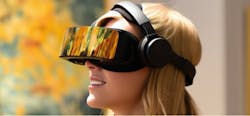AR/MR/VR Display
Augmented Reality (AR), Mixed Reality (MR), and Virtual Reality (VR) have rapidly advanced over the years, transforming the way we interact with digital content and the real world. At the heart of these technologies lies the display, a fundamental component which holds immense importance in delivering a seamless and captivating experience for users. With respect to AR/MR/VR applications, there are two major areas in which the display plays a significant role: There are two predominant types of displays in the realm of AR/VR technology: near-eye displays and projection displays. Near-eye displays are commonly found within VR headsets, where the display is positioned in close proximity to the user’s eyes. Conversely, projection displays are often found in applications such as AR smart glasses, where virtual images are projected onto a semi-transparent screen positioned in front of the user’s eyes. In the domain of AR/VR technology, optics are vital in both crafting high-quality displays and fostering user comfort. Optical components – primarily lenses, mirrors, and waveguides – are applied across both near-eye and projection displays to guide and direct the light emitted by the display, channeling it toward the user’s eyes. For example, lenses in near-eye displays focus light onto the user’s eyes, whereas projection displays utilize mirrors and waveguides to reflect and direct light toward the user’s eyes. The application of optical coatings is another common way to enhance AR/VR display performance. For instance, anti-reflection coatings can be applied to lenses and other optical components to reduce glare and refine image clarity. Augmented reality (AR) and mixed reality (MR) systems rely upon transparent displays to overlay virtual content upon the real world, a task which demands precise control of light direction and angle, as well as the ability to adjust the optical system’s focal length to match the distance of virtual objects. As such, optical elements such as waveguides and lenses, which direct and shape light, are foundational to the success of high-quality displays. Conversely, virtual reality (VR) primarily employs opaque displays to completely immerse users within virtual environments. As such, optical components bear significant importance in this realm, as the display must be able to create a convincing 3D image that appears to be at a fixed distance from the user, even as they move their head and eyes. As such, this objective requires high-resolution displays with a wide field of view and complex optical systems that can adjust the focus and alignment of the image for each eye. The AR/VR/MR landscape is not without its challenges, however. Among them are: Overall, optics plays a critical role in enabling the high-quality displays that are essential for creating immersive AR/VR experiences. Please contact us if you’d like to schedule a free consultation or request a quote on your next project.
